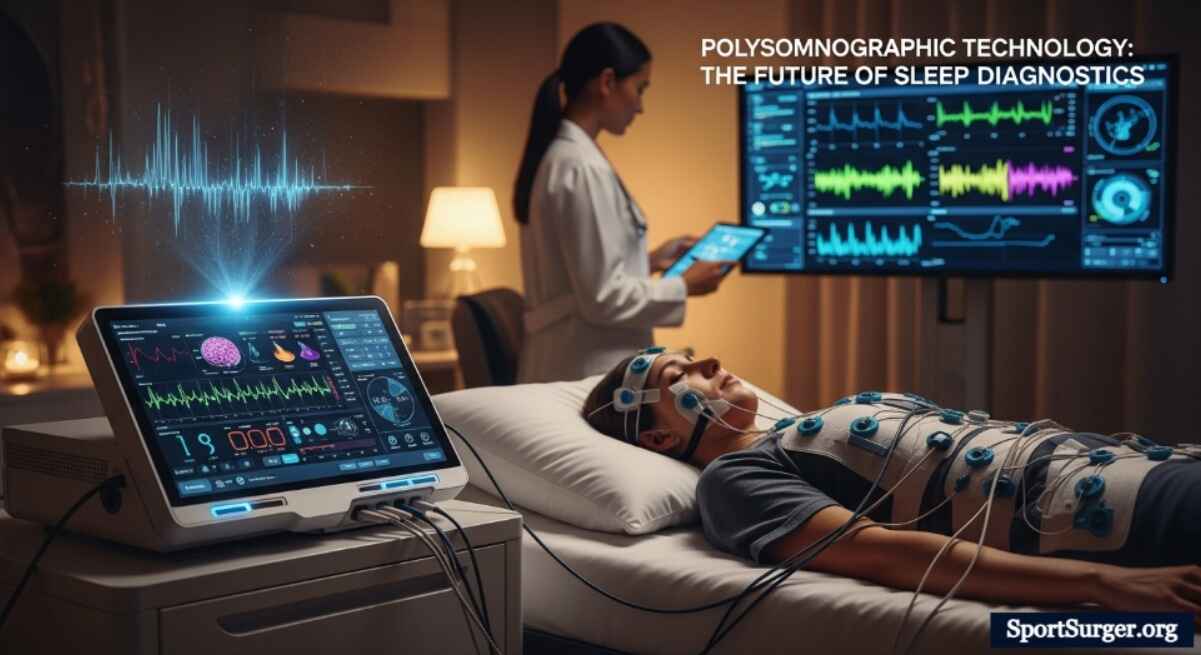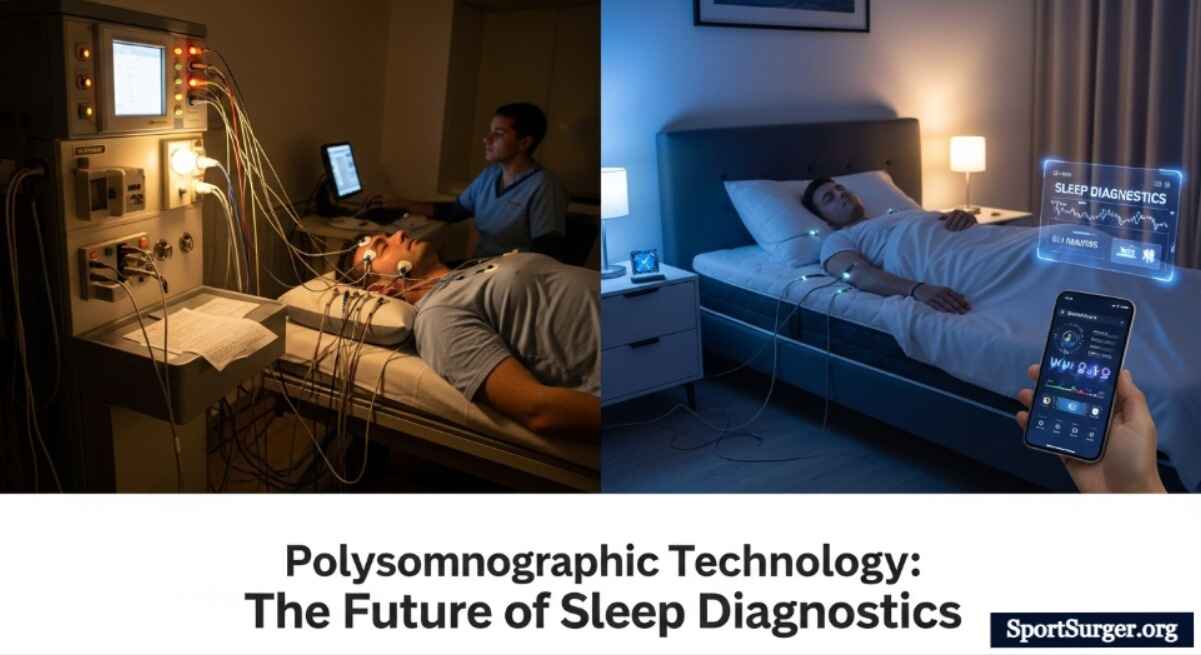Introduction
Sleep is one of the most vital components of human health, yet millions of people worldwide suffer from sleep disorders that go undiagnosed.
From insomnia to sleep apnea, untreated sleep-related conditions can negatively impact heart health, mental well-being, and daily productivity. This is where polysomnographic technology plays a transformative role.
Polysomnography is the gold standard in sleep diagnostics, using advanced monitoring systems to measure and analyze multiple physiological signals during sleep.
By leveraging polysomnographic technology, healthcare providers can gain a detailed picture of how the body functions during rest, leading to accurate diagnosis and effective treatment plans.
This article explores polysomnographic technology in depth—its history, components, procedures, benefits, challenges, and future trends—while presenting complex information in a clear, engaging way.
What is Polysomnographic Technology?
Polysomnographic technology refers to the systems and processes used to conduct polysomnography, a diagnostic sleep study that records multiple physiological signals simultaneously. The word “polysomnography” combines:
- Poly (many)
- Somnus (sleep)
- Graphy (to record)
This technology allows clinicians to monitor sleep stages and detect abnormal patterns that indicate disorders such as sleep apnea, restless leg syndrome, narcolepsy, and parasomnias.
The Evolution of Polysomnographic Technology
Polysomnography originated in the mid-20th century when researchers first began recording brain waves during sleep. Over the decades, the technology evolved from bulky, analog machines to highly advanced digital systems capable of real-time data collection and wireless monitoring.
- 1960s: First EEG-based sleep studies conducted.
- 1980s: Expansion to multi-signal monitoring including heart rate, muscle activity, and breathing.
- 2000s–present: Integration of digital, portable, and home-based polysomnographic devices.
Key Components of Polysomnographic Technology
A modern polysomnographic system integrates several sensors and recording devices to capture a wide range of physiological data.
1. Electroencephalogram (EEG)
- Measures brainwave activity to determine sleep stages (NREM and REM).
2. Electrooculogram (EOG)
- Tracks eye movements, especially rapid eye movement during REM sleep.
3. Electromyogram (EMG)
- Records muscle activity, including jaw and leg movements.
4. Electrocardiogram (ECG or EKG)
- Monitors heart rhythm and detects irregularities.
5. Respiratory Monitors
- Measure airflow through the nose and mouth.
- Detect chest and abdominal movement during breathing.
6. Oximetry Sensors
- Monitor oxygen saturation in the blood.
7. Video and Audio Recording
- Provide behavioral insights, such as body movements or snoring.
How Polysomnographic Technology Works

- Preparation
- Patient is connected to multiple sensors and electrodes.
- Baseline vitals are recorded.
- Patient is connected to multiple sensors and electrodes.
- Data Collection During Sleep
- Continuous monitoring of brain waves, heart rate, breathing, and oxygen levels.
- Sleep technologists observe remotely for any disruptions.
- Continuous monitoring of brain waves, heart rate, breathing, and oxygen levels.
- Data Analysis
- Sleep stages are charted using EEG data.
- Abnormalities like apnea events or limb movements are flagged.
- Sleep stages are charted using EEG data.
- Report Generation
- Detailed reports are provided to physicians for diagnosis.
Applications of Polysomnographic Technology
Polysomnographic technology plays a crucial role in clinical, research, and personal health contexts.
- Clinical Diagnosis: Sleep apnea, insomnia, narcolepsy, parasomnias, circadian rhythm disorders.
- Treatment Evaluation: Measuring effectiveness of CPAP therapy in sleep apnea patients.
- Research: Understanding brain activity, memory consolidation, and sleep’s impact on chronic diseases.
- Occupational Health: Screening for sleep disorders in high-risk professions like pilots or truck drivers.
Benefits of Polysomnographic Technology
- Accurate Diagnosis: Multi-signal monitoring ensures comprehensive insights.
- Early Intervention: Detects issues before they cause severe health complications.
- Customized Treatment: Data-driven analysis allows personalized care.
- Enhanced Patient Safety: Helps prevent accidents related to untreated sleep disorders.
Challenges and Limitations
While highly effective, polysomnographic technology has some challenges:
- Cost: Sleep studies can be expensive, limiting accessibility.
- Complex Setup: Requires specialized labs and trained technologists.
- Discomfort: Patients may find it difficult to sleep with sensors attached.
- Data Overload: Analyzing vast amounts of data requires expertise and advanced software.
Future of Polysomnographic Technology
Technological innovation is transforming how sleep is studied and monitored:
- Portable Home Devices: Making sleep studies more convenient.
- AI and Machine Learning: Enhancing accuracy in detecting sleep patterns.
- Wearable Sensors: Lightweight devices integrated into headbands or wristbands.
- Telemedicine Integration: Remote monitoring and digital consultations.
Expert Insights on Polysomnographic Technology
Sleep medicine experts emphasize the importance of polysomnography in diagnosing hidden conditions. For instance, untreated obstructive sleep apnea can lead to heart disease, hypertension, and stroke. By applying polysomnographic technology, clinicians can save lives through early detection and targeted treatments.
Polysomnographic Technology vs. Other Sleep Monitoring Methods
| Feature | Polysomnography | Actigraphy | Consumer Sleep Trackers |
| Signals Measured | Brain waves, heart rate, breathing, muscle activity, oxygen | Movement only | Movement, heart rate (limited) |
| Accuracy | High | Moderate | Low to moderate |
| Use Case | Clinical diagnosis | Sleep-wake patterns | Lifestyle monitoring |
Conclusion
Polysomnographic technology has revolutionized the way we understand and diagnose sleep disorders. By combining multi-signal monitoring with advanced data analysis, it enables precise diagnosis and effective treatment planning.
Despite challenges like cost and accessibility, continuous innovations such as home-based devices and AI-driven analysis promise to make this technology more accessible and efficient in the future.
Ultimately, investing in better sleep diagnostics through polysomnographic technology not only enhances individual health but also contributes to safer, healthier communities.

